There isn’t any doubt that one of the reasons Honda nameplates enjoy the popularity they do is because of their well-earned reputation for reliability. In fact, most of the Hondas you will service in your future will have routine problems that should prove to be easy to diagnose and profitable to repair. The other plus is that these vehicles give their owners such good service that they rarely are hesitant to make the investment in needed service or repair – which is a good situation for both the shop owner and the technician.
Honda does a great job of designing and building cars, but that’s not to say that they don’t require preventive maintenance or service, especially as their mileage increases. This article will cover some of the more prevalent driveability and electrical problems on these cars. Although I wouldn’t call any of these problems common or pattern failures, techs have encountered them often enough that when presented with certain symptoms, they know where to go.
Starting Off
The ultimate driveability/electrical complaint is a no-start, no-run situation. As with any driveability complaint, get as much information from the customer as you can. There is nothing more frustrating than having the car towed in, only for it to start right up when it gets off the truck. If the customer reports the following: “I turn the key and nothing happens,” ask if it seems to have a strong battery? If so, suggest they try turning the key to the start position a few times in quick succession. If the car starts, the problem is bad contacts in the starter. This will not only save the customer the expense of a tow job, it allows you to schedule the job as well as get the parts ready.
While the contacts are readily available, I would suggest a rebuilt unit and the warranty that goes with it. Be sure to use high-quality parts, especially when replacing the rotating electrical parts on Hondas. The starters usually are not a problem, but there are some problems with alternators. With the labor required to replace an alternator on most Hondas, you certainly can’t afford to replace defective units.
Trouble Turning Over
If the engine turns over and doesn’t start, there isn’t much the customer can report other than how the car ran the last time it was driven. Was it moved a short distance and turned off? Have there been any other starting problems? Long cranking time or a start-and-stall?
If the call comes in the late afternoon, ask if the car has been sitting in the sun all day. Why would we care if the car was sitting was in the sun? Because this is when the main relays fail.
The main relay in a Honda controls fuel pump operation, as well as power to the ECU and injectors. Their failure is usually intermittent and caused by bad connections on the circuit board. If you have a Honda that cranks, but doesn’t start in the heat of the day, yet operates fine in the cool of the evening, suspect this relay. You may be able to duplicate the situation by carefully heating up the relay with a heat gun and trying to start the car, but I wouldn’t bother.
The relay isn’t very expensive and is readily available, so if we are presented with this symptom, we always replace the part. You’ll find the relay under the dash, usually to the left of the steering column. On some models, you can remove the change holder for access; others may require removing trim panels. Some of them can be a little tough to find, so good service information will help here. You may find it helpful to have the replacement part in hand so you’ll know what you’re looking for.
Start-‘N-Stall
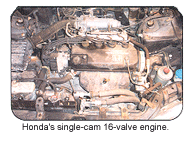 A start-and-stall situation will have me looking in a couple of directions. If you’re working on a carbureted car, they have a problem with fuel pumps that don’t run when first started. The car will start and run on the fuel in the float bowl, but will stall once the bowl goes empty. Like the starter, the fuel pump may run after we repeatedly send current to it and, once the pump runs, it will usually work well for the rest of the day, only to have the problem the next morning.
A start-and-stall situation will have me looking in a couple of directions. If you’re working on a carbureted car, they have a problem with fuel pumps that don’t run when first started. The car will start and run on the fuel in the float bowl, but will stall once the bowl goes empty. Like the starter, the fuel pump may run after we repeatedly send current to it and, once the pump runs, it will usually work well for the rest of the day, only to have the problem the next morning.
We confirm this problem by keeping the car overnight and starting it in the morning with a fuel pressure gauge installed. No pressure on initial startup will have us replacing the pump. Again, be sure to get a direct-fit replacement. Honda provides access in the storage area to replace the pump, making it an easy repair.
This doesn’t seem to a problem on the fuel-injected vehicles, but you can be presented with a similar complaint with a different solution. The complaint will be the car starts and turns right off. The problem may be the electrical part of the ignition switch. With this problem, the car acts like the key is in the off position after the stall. Oftentimes, just moving the key will light up the warning lights on the dash and wake up the accessories. The same technique can be used to get the problem to occur in the shop. If a slight movement of the key results in the engine or accessories turning off, replace the switch. On most models, you can just replace the electrical part of the switch, but some will require replacement of the lock assembly. Be sure to check what’s required before quoting a price.
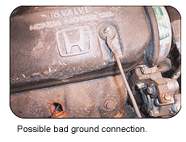 No-start, So-spark Complaint
No-start, So-spark Complaint
The first step is to be certain that the timing belt is intact and the distributor is turning. Most of the time, a broken belt is obvious with its fast-spinning, no-compression sounds that are apparent when the starter is engaged. However, I’ve been tricked by a car that sounds normal, but, in reality, the belt is broken. It only takes a few seconds to remove the oil cap and confirm that the camshaft is turning.
If the belt is good, our next step is to remove the distributor cap and check the condition of the distributor. After many miles, the bearings in the distributor tend to fail, resulting in contact between the cam and crank sensors and the shaft. Needless to say, they don’t last long after that point. A bad distributor will make plenty of noise and will be loaded with rusty-colored material. The failure will be obvious.
Sensor failures are very rare in distributors that don’t suffer from bearing failure. If you have a good, clean distributor that doesn’t make a spark, reach for your tach and dwell meter, or even a test light, and check for current switching at the negative side of the coil. If you get an RPM or dwell reading, or if the test light flashes, you have a bad ignition coil. Replace the coil and, at the same time, install a new distributor cap and rotor. It is also important that you check the condition of the spark plugs and wires. The coils fail as a result of working hard to overcome high resistance in the secondary system. To ensure a quality job, be sure the system is in good condition.
If you don’t get current switching at the negative side of the coil, it’s time to delve a little deeper into the system. As just mentioned, the sensors in the distributor are very reliable. If they fail, a code should be set.
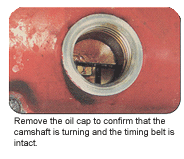 Honda’s Self-Diagnostic System
Honda’s Self-Diagnostic System
There are a couple of procedures for accessing the self diagnostics, depending on the vehicle year and model. Early Civics and Accords simply required finding the ECU, which was usually located in the front passenger-side footwell area or under the seat. Turn on the ignition and count the flashes of the LED in the computer. On later models, it is necessary to jump the two-wire test connector located under the right side of the dash to get the check engine lamp to flash codes. It can sometimes be a challenge to locate this connector. It may be clipped into a holder that will make you think it’s a harness connection. There is also a three-wire test connector that will allow you to not only retrieve codes, but will give you datastream information if you have the proper scanner.
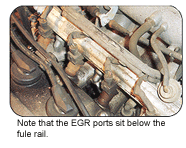 Needless to say, that equipment will give you quite a leg up on the diagnostic process, but the flash codes and good service information will give you what you need to fix the car. A no-code signal will be a quick flash of the lamp. If you don’t get any lamp, or the lamp stays lit, suspect no power (no lamp) or a bad ground (steady lamp) to the ECU. The power comes from the previously mentioned main relay, but be sure to check all the fuses before getting too far into the repair.
Needless to say, that equipment will give you quite a leg up on the diagnostic process, but the flash codes and good service information will give you what you need to fix the car. A no-code signal will be a quick flash of the lamp. If you don’t get any lamp, or the lamp stays lit, suspect no power (no lamp) or a bad ground (steady lamp) to the ECU. The power comes from the previously mentioned main relay, but be sure to check all the fuses before getting too far into the repair.
If you suspect a bad ground, take a good look at the connections on the thermostat housing. This connection is prone to corrosion damage as a result of coolant leaks and time, not to mention the damage that can occur during thermostat replacement. This is also the location of the main relay ground on many models. Needless to say, a bad connection here can cause many problems. Be sure to check it closely, and give the wires a slight tug to be sure they are secured to the terminal. If it is obvious that they have been previously repaired, be sure it was done properly.
Back to the coil that’s not being told to fire. If there are no codes present and you have the proper power and grounds, it’s safe to assume that the igniter is the culprit. Honda had problems with the igniters made by Okia and replaced most of them under campaigns, but it isn’t unusual to see one. If you are installing a replacement, it should be a unit from NEC.
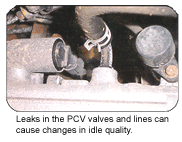 If you do get a code for one of the position sensors, confirm the problem. The distributor housing will have to be replaced. Before opting for a rebuilt or used part, check with your local Honda dealer. The most common part numbers are available as housings with position sensors, but no igniter or coil. They are surprisingly inexpensive. Depending on the mileage, you may recommend a new coil or igniter to go in the new housing. At the very least, be sure a new cap and rotor is installed with a little anti-seize compound on the cap screws.
If you do get a code for one of the position sensors, confirm the problem. The distributor housing will have to be replaced. Before opting for a rebuilt or used part, check with your local Honda dealer. The most common part numbers are available as housings with position sensors, but no igniter or coil. They are surprisingly inexpensive. Depending on the mileage, you may recommend a new coil or igniter to go in the new housing. At the very least, be sure a new cap and rotor is installed with a little anti-seize compound on the cap screws.
Poor-Run Conditions
Well, that takes care of the starting problems, but how about the car that has a poor-run condition. As always, the repair process starts with questioning the customer. What is the problem and when does it happen? A hesitation to one person may be a lack of power to another. A rough idle could be described as a vibration. Is the engine warm or cold, damp or wet weather, initial tip in or highway speeds? Has the check engine light been on?
Talking it Out
The more you can find out about the problem, the easier it will be to duplicate and diagnose. You’ll find that customers prefer to speak to the technician who is going to repair their car. With driveability complaints, if the service writer can’t understand what the client is experiencing, there is little chance that the technician will. In these situations, you, as the technician, may need to take a test-drive with the customer. If the problem is obvious, you may not have to leave the parking lot. Even if the problem doesn’t show up during the test drive, it’s a good time for you to further question the customer.
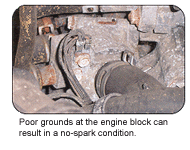 This exercise costs no time since the car would have to be road tested before any diagnoses could begin. Not to mention, it never hurts to have the technicians interact with the customers. I know my customers like to get to know the guys who are servicing their vehicles. It’s easier for the customer to trust a technician they know. And what technician doesn’t want to do a good job for someone they know.
This exercise costs no time since the car would have to be road tested before any diagnoses could begin. Not to mention, it never hurts to have the technicians interact with the customers. I know my customers like to get to know the guys who are servicing their vehicles. It’s easier for the customer to trust a technician they know. And what technician doesn’t want to do a good job for someone they know.
After you know the complaint, you can go about diagnosing and repairing this Honda. One of the most common complaints you’ll get with these cars is a roughness or miss on acceleration. If you don’t know the history of the vehicle, do yourself a favor and pull a spark plug to check the condition. These cars will perform very well with little maintenance, but some owners think that no service is required. Don’t make the mistake of trying to fix a driveability problem on a car that is in need of basic service. On the other hand, it isn’t smart to sell a “tuneup” as the first step. You will quickly lose credibility if you sell the service, but fail to solve the customer’s complaint.
Common Cures
When discussing Honda service, there are only a couple of areas that may give you some problems. Without a doubt, the most common issue is plugged EGR ports on the four-cylinder Accords. There have been some problems reported with the six-cylinder cars, but it seems they are being taken care of by Honda. The problem really isn’t with the plugged ports, but the one that remains clear. When the EGR opens during light-throttle application, all of the exhaust gases find their way to the cylinder that has the least restricted port, causing a misfire. This is a simple problem to diagnose. Just disconnect the vacuum line to the EGR valve and road-test the car. If the miss is gone, you’ve found the problem. The repair is not as simple, but it isn’t difficult.
Early-Model Cars: Take a look at the intake manifold where the EGR bolts on and you’ll see the channel that is cast in to deliver the exhaust gases to each cylinder. There is a port drilled from the top of the channel through the manifold that lets the exhaust gases enter the intake tract. These holes are sealed by small-core plugs that are pressed into the channel.
To clean the ports, it is necessary to remove these core plugs. The plugs aren’t available so care must be taken when removing them. Drill a small hole just deep enough to start a self-taping screw into the plug. Using pliers, remove the plugs to access the ports. The carbon is usually easy to remove from the ports. Reinstall the plugs and you’re ready to road test. Be sure to check and clear codes. Since you disconnected the EGR hose, there is a good chance an EGR code will be stored.
Late-Model Cars: Honda has made this process easier by covering the channel with a removable plate that allows easier access to the ports. This is good thing since the OBD II system is more sensitive to misfires than even the most perceptive driver. When faced with a misfire code, don’t forget to consider the EGR system as a possible cause. A word of warning – in order to access the plate on these cars, you will have to remove the injectors. Do yourself a favor and have a set of injector seals on hand. The small cost is not worth the chance of having an underhood fuel leak.
Remember, a wise man once said:
“Diagnosing and repairing driveability problems gives us the right to do the more profitable service work.”
Wise words indeed.


